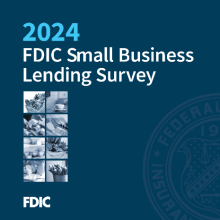FDIC Issues 2024 Small Business Lending Survey Report
WASHINGTON – The Federal Deposit Insurance Corporation (FDIC) today released the 2024 Small Business Lending Survey Report (SBLS). Conducted in 2022, the SBLS is a nationally representative sample of U.S. banks that offers important insights into their small business lending practices and how banks meet the credit needs of the nation’s small businesses.

The SBLS gathered responses from over a quarter of the nation’s banks on the way they approve and underwrite small business loans, their geographic markets and competition, their use of financial technology, and their lending to start-ups. Overall, the FDIC’s survey found that while most banks are adopting new technologies, these innovations have not replaced the relationship-oriented and staff-intensive nature of small business lending that continues to be focused around local branch office locations.
In a keynote address to the 12th Annual Community Banking Research Conference at the Federal Reserve Bank of St. Louis today, FDIC Chairman Martin J. Gruenberg said the SBLS shows the importance banks continue to place on relationship lending:
“From the smallest to the largest banks, small business lending is generally underwritten and approved by people. In this sense, small business lending at banks is one of the forms of lending that has remained the most consistent and traditional in how it is conducted. This survey also affirms that the community banking model of small business lending remains highly competitive in today’s financial market, and is still vital for our communities.”
SBLS Findings
- Approximately half of U.S. banks were using or considering using financial technology in their small business lending process. However, nearly all banks emphasized in-person and high-touch practices for developing relationships with their small business customers while using technology to help with regulatory compliance, data management, and servicing small business loans after loan approval. While remote communication methods such as email, file transfer, and video conferencing are ubiquitous in the U.S banking sector, they often supplement rather than replace in-person interaction. For example, very few banks allow borrowers to complete a small business loan application entirely online.
- Nearly all banks make small business loans of at least $1 million and half of banks make loans up to $3 million to small businesses. In addition, banks generally retain the risk of small business loans on their balance sheets.
- Small and large banks emphasize different types of information when making small business loans, particularly smaller loans. Small banks use more “soft” or difficult-to-quantify underwriting information gathered through relationships than large banks. Especially for smaller loans, large banks tend to focus more heavily on using “hard” quantitative information from credit bureaus when evaluating loan applications.
- Small business loan approval times are fast, especially for small loans at large banks. Three-in-ten banks, including more than half of large banks, can approve a small and simple loan within one business day. Three-in-four banks can approve a small and simple loan within five business days; three-in-four banks approve their typical small business loan within 10 business days.
- Banks use and highly value branch locations and on-site visits to generate and maintain small business lending relationships. Small business borrowers are generally located close to a bank’s branch locations.
- Bank competition with credit unions and non-bank financial technology companies (FinTechs) appears to be growing. Small banks are more likely to compete regularly with credit unions, while large banks are more likely to compete regularly with FinTech lenders, credit card issuers, and other financing companies.
- Small and large banks take different approaches to managing the risk of lending to start-ups. Large banks more often rely on government guarantees (such as those provided by the Small Business Administration) while small banks more often use soft information gleaned from meeting with applicants.
About the Survey
The Small Business Lending Survey (SBLS) is a nationally representative survey that asks banks about their small business lending practices. From a sample size of 2,000 banks, about 1,300 banks—more than a quarter of all banks in the nation—responded, yielding a 68 percent survey response rate. This large and nationally-representative sample allows for a comprehensive view of small business lending by banks. The report documents the many similarities across the banking industry but also highlights some key differences, such as the differences between small and large banks.
